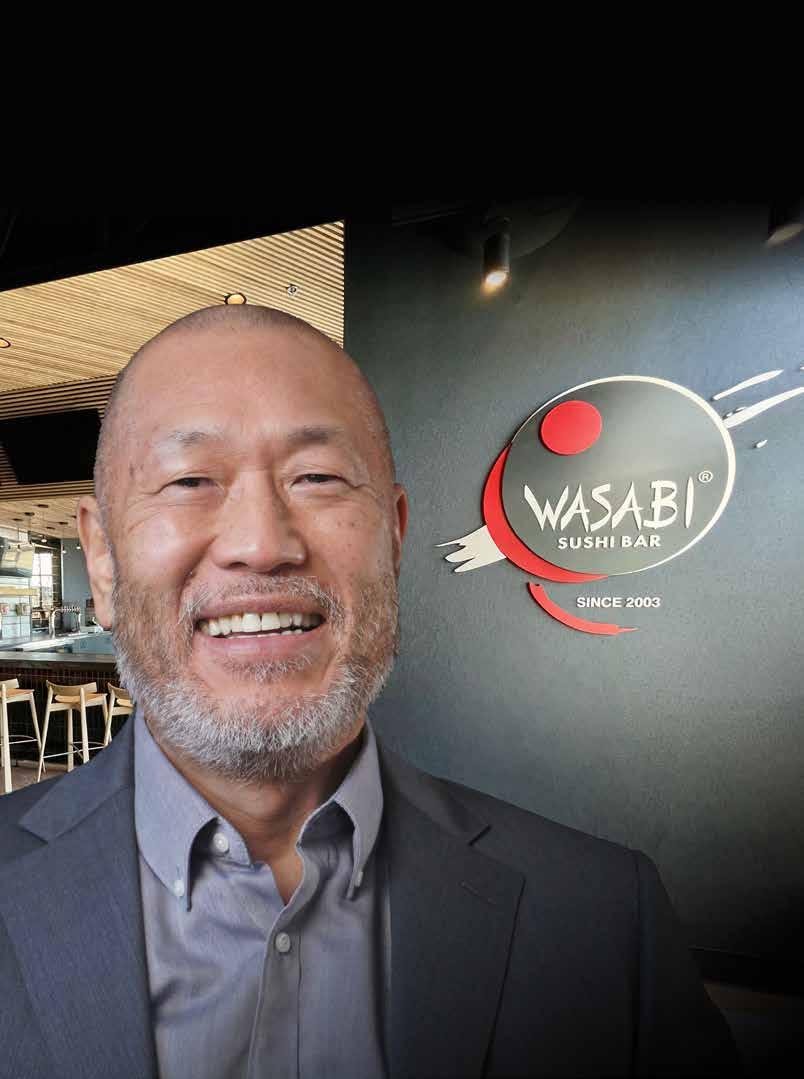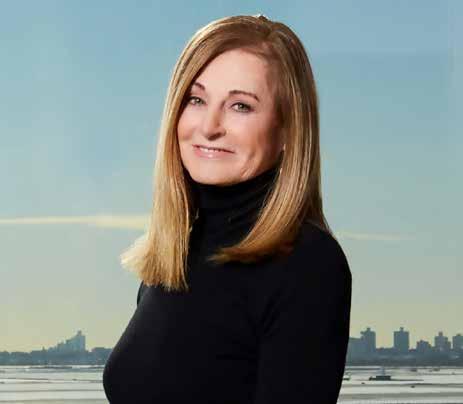
33 minute read
Industry News
from CCR Issue 2, 2021
AroundtheIndustry
RETAIL
Target Stores/Apple
Target will unveil an expanded selection of iPads, iPhones and other Apple devices in special sections in 17 stores starting this quarter, with plans to roll out the enhanced Apple-branded sections to more locations later on. The new experience has debuted on Target’s e-commerce site and the in-store shops will be staffed by Apple-trained employees.
Best Buy
Best Buy is experimenting with a store format that cuts selling space down from about 27,000 square feet to 15,000 and dedicates the rest of the space to e-commerce fulfillment. The retailer started testing the format at four Minneapolis stores last year and plans to expand it to one or two more markets.
Sephora
Sephora plans to add more stores as it pushes ahead to attract shoppers outside of struggling US malls. The company will add more than 60 freestanding stores this year—85% of which won’t be in malls. The new stores come on top of its previously announced 200 Sephora “mini shops” inside of Kohl’s stores.
Dick’s Sporting Goods
Dick’s Sporting Goods plans to expand its physical footprint this quarter with the launch of five locations—one namesake location in Concord, North Carolina, and four Warehouse Sale units in Friendswood, Texas; Oklahoma City; Deer Park, New York; and Kissimmee, Florida.
Dollar General
Dollar General has introduced a new retail concept dubbed Popshelf, with plans to open the first two locations near Nashville this fall and the goal of having about 30 US stores running by the end of the 2021 fiscal year. Popshelf stores are designed to appeal to higher-income consumers with a focus on nonessentials, including home decor, beauty supplies and party goods.
Lidl
Lidl will spend $10.5 million on wage increases as part of a larger $1.7 billion growth plan that calls for growing to 1,000 UK stores over the next three years. RESTAURANT
Noodles & Company
Noodles & Company is focusing on the South for future growth, with plans to find franchisees to open new units in six states. The chain expects to sign new operators by this summer and start opening stores in the new markets next year.
Lil’ Sweet Chick
New York City-based chain Lil’ Sweet Chick, which was forced to close indoor dining across all five locations in NYC and Los Angeles, is moving to a limited service format, including a new logo, branding, menus and indoor flow.
Spago/ Spago L’extérieur
Wolfgang Puck is expanding Spago with a 6,500-square-foot outdoor dining area in front of the Beverly Hills, California restaurant. The new space, called Spago L’extérieur, is located in the Canon Drive cul-de-sac. It will feature a large tent with slotted walls, vented semi-private seating areas, a cocktail lounge and lobby. The modular structure is designed to adapt to changing dining restrictions.
Shake Shack
Shake Shack plans to grow its roster of restaurants by 45% over the next two years with 10% of those planned for new markets. The chain’s recovery will hinge on a revival in urban markets and a return to widespread travel.
Salt & Straw
Premium ice cream retailer Salt & Straw has expanded beyond the West Coast with the opening of the first of two planned Miami scoop shops. The 10-year-old company, which has backing from Shake Shack founder Danny Meyer, also has grown its local delivery and national shipping during the pandemic.
Starbucks
Starbucks built its business on being a gathering place as much as a seller of coffee, but the pandemic has spurred the chain to focus on new formats. The drive-thru has become the chain’s most productive model, and its “future drive-thru concept” will include smaller stores, drive-thru only units and other changes designed to serve new customer demands.
Sweetgreen
Sweetgreen plans to reach carbon neutrality by 2027, using software platform Watershed to help it reduce carbon emissions. The 109-unit chain will take several steps to reach its goal, including making clean energy investments, sourcing sustainably, building with eco-friendly materials and crafting more plant-forward menus.
The Grey
Chef Mashama Bailey and business partner John Morisano of celebrated Savannah, Georgia restaurant, The Grey, will expand the brand with the opening of two restaurants in a forthcoming Austin, Texas, hotel. The Grey Diner Bar will feature a cocktail bar and snacks, while the Grey Market will have a “bodega-meets-lunch counter” concept with to-go items and casual fare.
Whole Foods Market
Whole Foods Market plans to acquire Jackson Whole Grocer in Jackson, Wyoming, marking its first location in the state. The grocer also plans to open its first Montana store in Bozeman, although a date has not yet been announced.
ALDI
ALDI plans to open 100 new stores this year, putting special focus on Arizona, California, Florida and the Northeast.
HOSPITALITY
Legoland New York Resort
Legoland New York Resort will open in Goshen this year as planned after reopening guidance for amusement parks in the state were reissued. The 150-acre theme park, developed by Merlin Entertainments, will feature a 250-room Legoland Hotel and more than 50 shows, attractions and rides, including the “Lego Factory Adventure.”
Godfrey Hotel
Plans for a new 227-room hotel in Detroit’s Corktown took a step forward with the proposed seven-story, $74-million Godfrey Hotel. The announcement comes pending the demolition of a vacant building that years ago housed administrative offices for the Detroit Lions and later the City Cab Co.
InterContinental Hotels Group (IHG) has renamed itself IHG Hotels & Resorts in an effort to redesign and revitalize a portfolio that boasts 16 brands and nearly 6,000 hotels in 100 countries. The younger generation of travelers is the key target of a new image presented in four categories: Luxury & Lifestyle, Premium, Essentials and Suites.
Planet Hollywood
The Planet Hollywood Beach Resort Cancun made its debut on the shores of Costa Mujeres, bringing 898 rooms, 13 gourmet restaurants, nine bars and a trove of Hollywood memorabilia. Two of the restaurants are reserved for the Adult Scene, a distinct adults-only “resort within a resort.”
Graduate Hotels
Graduate Hotels is among the first participants in a collaborative expansion campaign by restaurant innovator C3 that engages hotels, shopping centers and other entities in a full range of onsite and remote food service. Graduate Berkeley, California will host the initial Graduate Food Hall, to be followed by expansion to campuses in Arizona, Iowa and Minnesota.
Marriott International
Marriott International is acquiring 19 resorts with nearly 7,000 rooms in the Caribbean and Central America from Sunwing Travel Group as a vote of confidence in post-pandemic vacation resurgence.
Barfield Hotel
The first luxury hotel in Amarillo, Texas retains both its 1920s decor and Prohibition-defying speakeasy setup. The refurbished hotel also features the city’s first bourbon bar and an Italian steakhouse along with bullet holes and secret rooms.
Virgin Hotels
Virgin Hotels plans to open three new hotels this year, beginning with Las Vegas and following with New Orleans and New York City. Edinburgh, Scotland is on the agenda for 2022 and Miami in 2023.
Wyndham Hotels & Resorts
Wyndham Hotels & Resorts plans to open 10 new hotels throughout Mexico by the end of 2022, starting with the 96-room Esplendor by Wyndham Tulum Nook by mid-2021. The brand’s second property in the country will be the 112-room Esplendor by Wyndham La Condesa in Mexico City, slated for later this year.
Big Sky Resort
Montage Big Sky will make its debut this year at Montana’s Big Sky Resort, one of America’s premier skiing venues. The resort will include 150 guestrooms and suites, 39 residences, 12,870 square feet of meeting and event space and an 11,000-square-foot spa.
Roll me away
Mobile stage earns rave reviews at Denver’s Mission Ballroom
If we learned anything in this pandemic, it is that anything is possible. Take Denver’s state of the art Mission Ballroom. When the venue was looking for a flexible and mobile stage design for its world-renowned headliners and other live acts, Minneapolis-based Staging Concepts had a solution—the custom-built SC2003 portable rolling stage. Take that pandemic. The mobile stage features a retractable caster assembly so that it can roll across a flat floor while completely assembled. The stage consists of a support structure and three 4-foot x 8-foot SC90 Platforms. Multiple rolling stages can bridge the platforms to create a larger performance area. The Mission Ballrooms’ new rolling stage is 40 feet x 60 feet and can be made smaller to accommodate different event sizes. Featuring flexibility and convenient transport, the SC2003 Rolling Stage provides a sleek, efficient solution to cater anywhere from a few hundred now to 3,500 guests post-pandemic. And get this, either way, the venue will still feel like full occupancy. In addition to the rolling stage, Staging Concepts also provided drum risers and custom speaker shelves. The drum risers are used throughout the Mission Ballroom, while the custom speaker shelves hang off the front of the stage to enhance sound quality within the performance space. Additionally, after the initial installation of this equipment, Staging Concepts added another 20-foot x 60-foot, non-rolling thrust to the rolling stage, so it could be 60 feet x 60 feet overall.
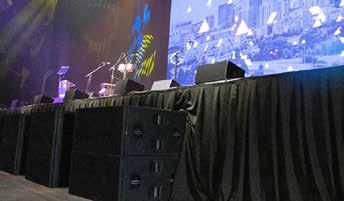
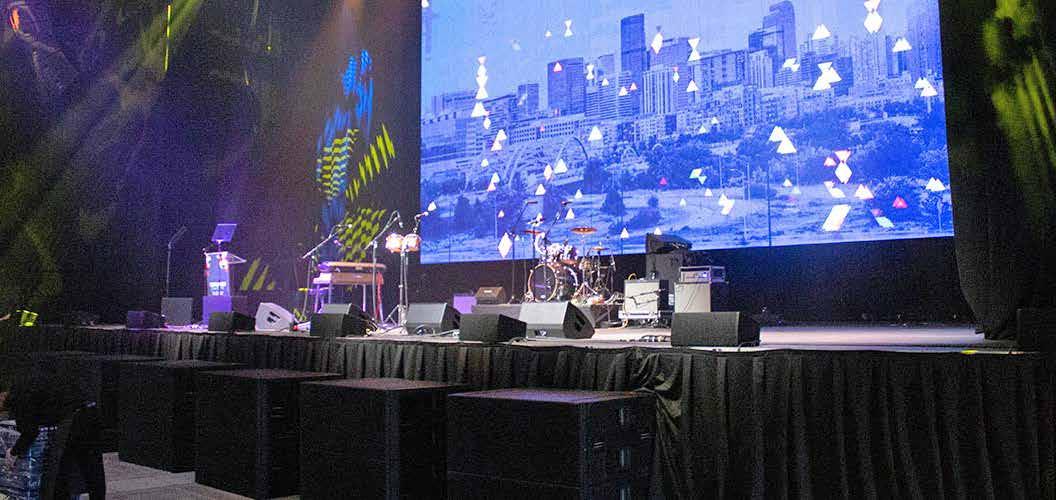
They said it
— SaladWorks CEO Kelly Roddy on the fast casual brand’s recent growth strategy
— NRF Chief Economist Jack Kleinhenz on the prediction that retail sales are expected to surpass $4.33T this year
— Saks Fifth Avenue President and CEO Marc Metrick on what the pandemic has taught luxury retailers
EONTM MODEL EL3

Three Phase Centralized Emergency Lighting Inverter Now Available Up To 55 kW!

LED Fixture / Driver Compatibility
High peak overload capability of 1700% to accommodate inrush current from LED fixtures / drivers while fed from the AC power source, or even while in battery mode.
Full Compliance With NFPA 101
Computer-based, self-testing / self-diagnostic emergency lighting system with data-logging and remote communications via BACnet, MODBUS, and Ethernet.
Compact, Space-Saving Footprint
Physically smaller than comparable three-phase emergency lighting inverter products, without compromising performance or serviceability.
10 kW – 55 kW Download a brochure and specifications today!
UL 924 Listed — Emergency Lighting Equipment C-UL Listed to CSA C22.2 No. 141-10; 141-15
www.controlledpwr.com/EON_1
It’s an outlet thing
Mall traffic showing hint of return
In the last week of September 2020, a funny thing happened—foot traffic at the nation's outlet malls started to creep back to 2019 levels. According to Placer Labs Inc., consumer visits were only off 6.4% on a year over year basis—and even climbed above pre-pandemic totals by 13.9%. Industry insiders say that the rebound offers a stark contrast to the sector's 96.8% decline that ended just as the pandemic took hold last year at the end of March. So, what does that mean for malls? By comparison, consumer foot traffic at traditional US indoor malls was off 33.3% on a year over year basis.
The numbers game 900+

The number of US hotel openings there were in 2020 despite the impact of the pandemic, according to Lodging Econometrics. This year, more than 960 openings are expected as owners of newly opened properties navigate cleanliness protocols and other pandemic-fueled challenges.
1,000,000
The number of hotel rooms that the Hilton Hotels & Resorts has reached thanks in part due to hotel openings in China, South Africa and Savannah, Georgia. The company’s development pipeline includes more than 408,000 rooms and 2,640 hotels.
21
The percentage increase in spending that business travel should expect in 2021 compared to 2020, according to Global Business Travel Association’s “BTI Outlook.” A complete recovery is not expected until 2025, the association said.

Beauty and the (Retail) Beast
Why more retailers are investing in beauty departments
Don’t look now, but beauty is becoming a major item on the to-do lists of many mass retailers. For proof, check out what some major brands are doing to increase their investments in segments that include fragrance, cosmetics and nail care. For example, Target continues to become home for hundreds of Ulta Beauty in-store shops, while Kohl's recently began testing the Wellness Market concept at 50 locations. Part of the shift can be attributed to the fact that America’s department store makeup counters are losing their clout, which has provided a window of opportunity for other players to grow in the space. Why? According to retail analytics firm First Insight, 41% of people said they felt either “unsafe” or “very unsafe” testing beauty products in stores during the pandemic. Overall, sales of prestige beauty products in the US, which have primarily been sold in department stores, dropped 17% year over year to $3.7 billion during the third quarter, according to data from The NPD Group. But, as sales of items like fragrances creep up, retailers are hoping to attract a younger consumer base.
A new kind of house hunting
Potential for residential developments seen in empty California shopping centers
As the pains of COVID continue to drive the need for affordable rental units, a California housing group may have found a solution in an equation that is worth exploring: Empty shopping centers + legislation = residential developments. In a state that needs 1.3 million more affordable rental units, the California Housing Partnership believes that legislation aimed at making it easier for developers to turn empty shopping centers into residential units is encouraging. If the legislation, introduced at the end of 2020 is successful, it could help fill a need that is sorely needed. According to developers, there are three main types of projects ripe for reuse, including commercial strips in more urban areas, often along existing transit lines; former big box retailers in more suburban areas; and vacant land in the exurban landscape that has been reserved for future development.
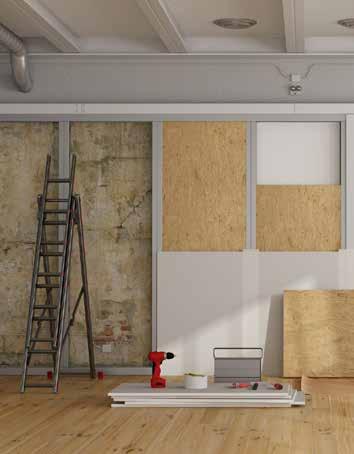
EST 2010

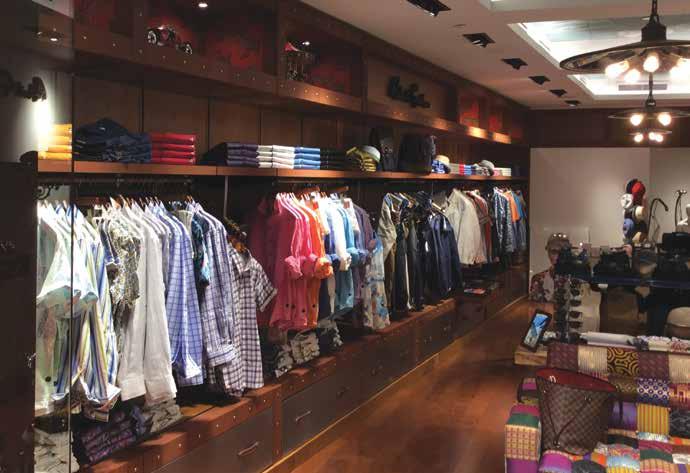
Pivot like this
Architecture adjusting to the impact of COVID-19 on the fly
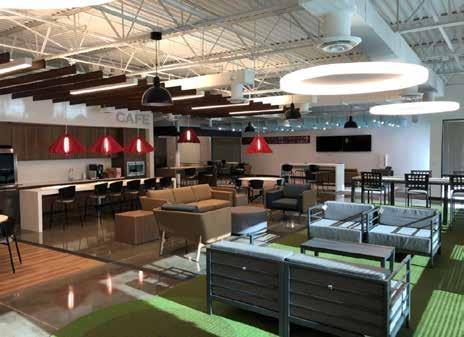
Millions of working people spent a third or more of their lives in the office until COVID-19, when the resulting lockdown brought that to a screeching halt. Nobody knew what to expect, and there was no time to plan for a mass migration to working from home at companies that were inexperienced in it. Fear and uncertainty are always disruptive, and there was plenty of it.
Still, few companies were shutting down operations; they were simply happening from home. It was a great unknown, but most assumed this was temporary. More than half a year later, the remarkable adjustments made in real time are proving those assumptions wrong. As architects, our job is to keep up with what's happening in real time and adapt to what’s normal moving forward. The pandemic proved to be the catalyst that forced people to work from home for their own safety, and it appears the option of remote work will not recede when COVID retreats. Indicators show productivity has remained high, pleasing owners and managers. Workers appreciate the flexibility. Companies forged ahead and, without much pain, put to work the minimally used software and infrastructure they already had in place. It is as if we were prepared to adjust to this without knowing it. In my office, only one person needed new equipment. Additionally, I have also yet to come across a single instance where an employee’s sudden and unique challenges were met with resistance or insensitivity. It has become clear that people are the most important asset and relatively minor, reasonable accommodations go a long way to keeping them happy. Maintaining this balance will mean rethinking what the workplace looks like. To that end, smart owners turned to an analysis of what companies are spending on square footage and furnishings for employees. Expenses for new construction, property acquisition, lease rates renovation and more are all being reconsidered. Moving forward, appropriate spacing that maintains the ability to collaborate, while keeping people safe is the No. 1 priority. At the same time, we must resist the temptation to hop on every bandwagon relating to surface cleaning, “new” air purification systems and other options that seem too good to be true. The research is underway. It is best to wait and find out what really works and how new HVAC systems will introduce more fresh air. I have personally seen half a dozen proposals that are no better than snake oil.
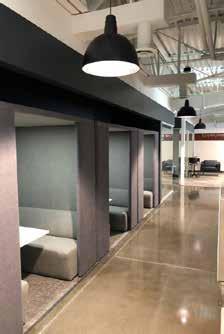
By Brian Felder
A change has come
Another unavoidable reality is that the workplace has changed forever. Designers and clients have embraced the need for a certain amount of healthful distance. Therefore, the office environment must adjust to the reality of 30%-50% of employees not being there 100% of the time. I was as guilty as anyone in thinking people had to be in the office all the time to be effective. When we did not miss a beat after this started, I changed my mind. This is as much of a cultural and attitudinal shift as new professional design guidance for architects. We need to design places that accept that flexibility. This is reality. For the last 10-15 years, we have seen a move away from corner and perimeter offices
and a push to make the workplace more egalitarian. This resulted in a reduction of overall office square footage, but it came at a cost. The average of 40 square foot per person was shrinking to as little as 15 square feet to 20 square feet. Now that offices will no longer be set up for maximum capacity, the per-person space is increasing, with the addition of partitions or barriers that allow for isolation without walls or cubicles. Oversized conference rooms also are likely to be a thing of the past. An immediate, but expected change is touch-free toilets and sinks. Our firm has a change order on every project that did not originally include them. Subtle but easy safety measures like these have quickly become the standard. Another major shift that happened right away is a massive reduction in business travel. Typically, I would take two trips a month. In the last six months, I have made one. This has had literally no negative effect on business. The success story of remote work means companies are analyzing how much time employees can spend at home and at the office. Managers are free to schedule shifts like manufacturing once was, taking into consideration the number of hours employees need to be on-site to fulfill their responsibilities. Using four work stations for six employees represents a full one-third reduction in square footage, furnishings and other expenses. To provide all workers with dedicated personal space, something as simple as a locker may prove to be an adequate solution. An open mind is essential to stay on top of this rapidly changing landscape. Clients have had great ideas to change their space to make work from home a success. Listening to the people in orbit around us, from clients to interior designers and furniture manufacturers, allows us to learn as we go. Find out what they are doing to keep a safe distance in the office, foster collaboration and provide a well-lit comfortable environment. Efficient use of space tempered by a focus on the health and humanity of those who use it ensures that the unexpected positive effects of this pandemic endure. CCR
Brian K. Felder is the founder and principal of Felder & Associates (www.felderassociates.net) of Savannah, Georgia, an architecture firm specializing in architectural interior design and historic preservation services. He is a Trustee of the Historic Savannah Foundation and winner of several HSF Preservation Awards. Felder graduated from Virginia Polytechnic Institute and State University with a Bachelor of Architecture. He founded Felder & Associates in 2012. He can be reached at brian@felderassociates.net.



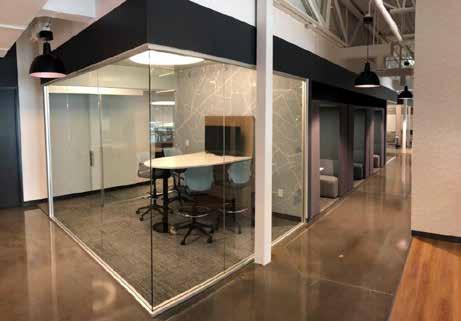
Wellbeing first
What contentment means in today’s built environment By Katie Sprague & Clay Markham
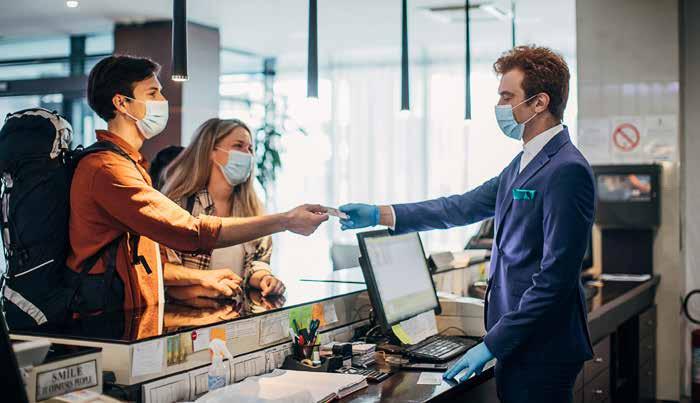
Hospitality—including hotels, resorts and restaurants that were once frequented by many—has been one of the hardest hit industries by COVID-19. While wellness has been top-of-mind in recent months for designers, we will continue to see this industry explore even more ways to define what it means to offer wellness and put travelers’ wellbeing first.
This is especially true amid the coronavirus pandemic, where the topic of wellness will gain more traction as more travelers become increasingly conscious of their own health and wellbeing, while also feeling comfortable heading to their favorite hotel again. With a rapidly changing economic environment surrounding the hotel industry, the ability to make spaces that put wellness first is paramount. The businesses that survive this pandemic will leverage our evolving world to serve fundamental, unchanging human needs: connection, empathy, freedom, wellbeing and, maybe more importantly, happiness. As designers, we’re on a pursuit to understand the role of happiness in the built environment and its impact on our wellbeing. Social connectedness is the bedrock of happiness, and our team, along with partners Delivering Happiness and DMG Mountain View, are taking this matter to heart. Happiness By Design is a methodology created to measure and apply happiness in the built environment. The project began with a series of questions: How can we make an impact on the world by driving happiness in the built environment? How might we play a role in the movement for human happiness by evolving the traditional design process? How might we connect people, places and culture through the common lens of happiness? Based on the science of happiness and design, the team created The Happiness Ecosystem Index (HEI). This system provides a roadmap to make better connections between buildings and the people who inhabit them. The HEI includes five principles of happiness: 1. Meaning: Alignment to a higher purpose
2. Vitality: Health and wellbeing as the foundation of life
3. Freedom: Autonomy, authenticity and empowerment
4. Engagement: Meaningful connections and a deep sense of belonging
5. Delight: Active awareness of joy and amazement
The hospitality industry has been quick to adapt to the pandemic, knowing its ability

to provide a clean and safe environment will be key to guest confidence once they return to the property. But the challenge presented lies in the long-term approach. How can hotel developers, owners and operators regain the magic of a great hotel experience that has always depended on beautiful spaces, delightful details and thoughtful service to bring it all together? The Happiness principle of Delight will be key to evolving hospitality design with a strong focus on high satisfaction and priority placed on guests’ wellbeing. Hotels are likely to be at the forefront of the “touchless experience” with guests using their smartphones and other devices to make their stay enjoyable while being seamless—from the check-in process to opening doors and ordering room service. The need for human connection is a constant, but now conducted at a respectful distance. Additionally, unlike how the healthcare industry can wear the badge of “sanitized for your health” with pride, hotel design will embrace the idea of “ambient wellness,” where spaces are visibly clean, and promote health and wellbeing, but will not have an overriding sense of virus-protection. For example, expected layouts will start to shift, and even hotels located in colder climates will place great emphasis on outdoor offerings and experiences. Furthermore, where there was once a large focus on more open, social spaces, the demand now will be for creating more exclusive, private areas that only accommodate a few guests at a time—showcasing the importance of guests’ wellbeing while offering an intimate experience worth traveling for. In addition to layout changes that support touchless encounters and ambient wellness, guests also will notice changes to the material and color palettes used throughout hotel properties. Guests are more conscious than ever of where they lay their heads, put their luggage and sit down to remotely work. With this in mind, properties will not only incorporate easily cleanable and antimicrobial surfaces, but will provide materials that feel good to the touch as well. Soft, natural elements that provide a sense of calm, combined with biophilic characteristics that prioritizes wellbeing will amplify the feeling of happiness alongside current safety guidelines. In that same vein, lighting and sound are tantamount to wellness. Hotels must focus on implementing an abundance of natural and circadian lighting throughout guestrooms, corridors and public spaces—wherever possible for maximum guest comfort. Additionally, natural, uplifting sounds that bring a sense of the outdoors inside will provide a positive, relaxing and happy experience for guests as they check in, head to an onsite food and beverage space or go to their guestroom. Utilizing all of the senses through thoughtful materials, tones, illumination and sounds will assure guests have a memorable experience that caters to their health, safety and overall happiness and well-being. Ultimately, owners and operators of hospitality spaces will need to be equally as focused on the wellbeing and happiness of their guests as they are on their property’s programming. Creating experiential spaces with a focus on wellness at their core will leave guests with memories that make the risk of traveling worth the reward. CCR
Katie Sprague leads branding for CallisonRTKL’s commercial sector. As a brand strategist, she brings complementary components to the traditional CallisonRTKL architectural design process, focusing on research, analysis and the human experience. Her international, award-winning branding projects span all the project types in CallisonRTKL’s portfolio, from retail and hospitality to residential and healthcare.
Clay Markham leads the hospitality sector with a dynamic design and management approach to architecture, interior design and construction management. Through more than 40 years in the industry, he has worked extensively on international projects, allowing him to apply diverse market experiences to a variety of project types from single-use environments to large-scale master plans to mixed-use projects. His compelling designs and successful project delivery skills have resulted in award-winning projects for top-tier brands including Marriott, Hyatt, IHG and Caesars Entertainment.


Beauty. Health. Empowerment.
How Kalvera Skin Therapy is helping empower today’s women
Interview by Michael J. Pallerino
Founders Dr. Kalpana Sundar and Slade Sundar built Kalvera Skin Therapy under the premise that beauty should be unbound from the expectations and insecurities the beauty industry has put upon people. The sister and brother team believe that everyone is beautiful when they have healthy skin and a healthy attitude toward themselves.
Through Kalvera Skin Therapy, their goal continues to help everyday people find confidence in their own skin via clean products and high-tech treatments that are medically effective at restoring their skin’s health. An entrepreneur, speaker and board certified physician, Dr. Kalpana has spent the past 20-plus years extolling the philosophy that true beauty comes from within. A cancer survivor, her journey sparked the investigation into cancer-causing chemicals in products we rely on daily, starting with our skin. She eventually found that products from well-known brands were full of chemicals linked to cancer and that most mainstream brands are not transparent about their ingredients, or who is really behind their companies. As a seasoned entrepreneur, Slade is an advocate for under-represented entrepreneurs (women, people of color, and LGBTQ+). Like his sister, he is a cancer survivor who is passionate about people being confident in their own skins and defining their own beauty in life. Prior to co-founding Kalvera, Slade spent more than 20 years in startup leadership roles in marketing, HR, operations, strategy, sales, software and product development. Together, they are moving the Kalvera Skin Therapy mission forward. To get a feel for their plans and mission statement, we sat down with Dr. Kalpana Sundar and Slade Sundar.
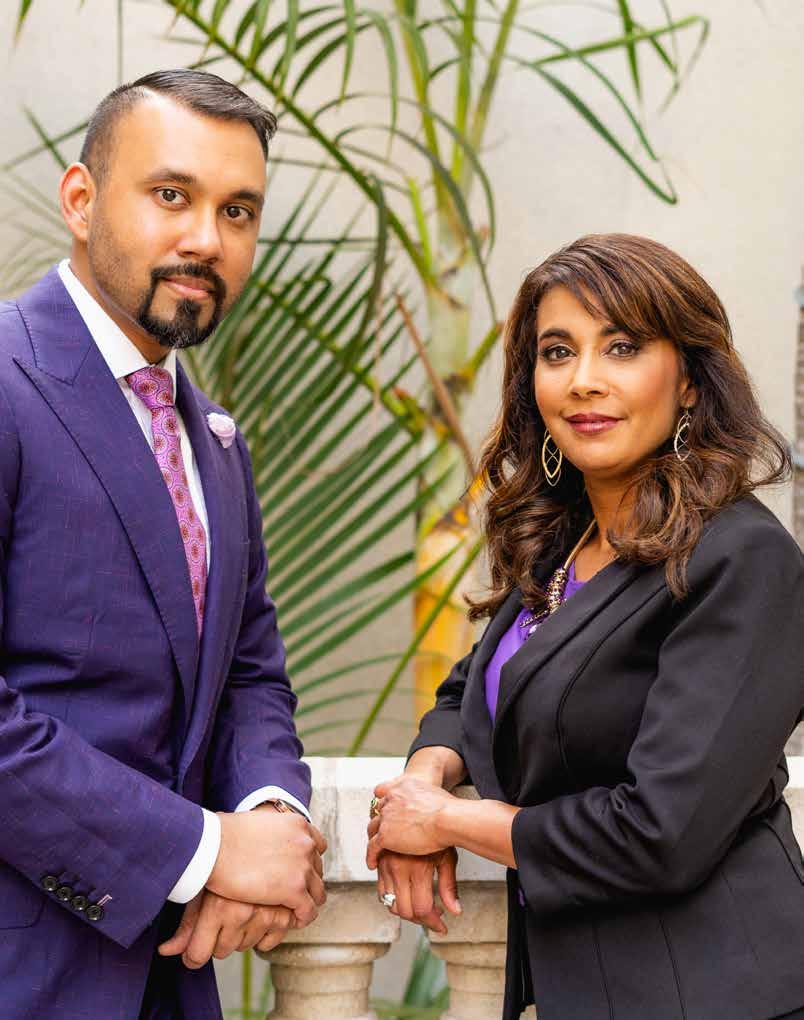
Give us a snapshot of the brand?
Dr. Kalpana: We often say we’re in the confidence business. We create confidence through skin health. Kalvera takes a data-driven, tech-infused approach to skincare, using data to assess the skin, providing customized med-tech facials and physician-formulated products to get your skin to its healthiest, most beautiful state. Our mission is to help people embrace their whole selves by making everyone more comfortable in their skin.
Slade: A big focus of the brand is on long-term skin health and non-comparative beauty. Kalvera celebrates each individual’s beauty and empowers them to heal their skin—and more importantly, their self-confidence—instead of covering up their skin or who they are as a person to please society. We embrace the beauty of each person as art, and we discourage people from comparing their beauty to the beauty of others.

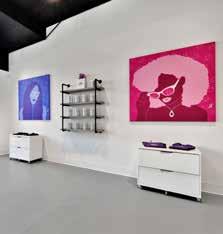
– Dr. Kalpana Sundar
What type of consumers are you targeting? What are they looking for?
Dr. Kalpana: Our customers are the types of people who want their skin to reflect who they are on the inside. People who want to see their most authentic and healthy selves in the mirror. People who don’t want to be defined by their age. People who not only want to see results, but also want to track the progress of their skin’s health.
Slade: We are also for anyone who has been confused or frustrated by the overwhelming amount of conflicting skincare information found online. Selecting skincare products is confusing, and most standard “fluff and buff” facials from skin spas feel nice, but do very little to heal the ongoing environmental damage to the skin. There’s usually no way to track the progress of your skin except by looking in the mirror. Kalvera is different because we use data from the skin scan to monitor a client’s progress every time they come in. We use skin scan data to personalize each client’s regimen on an ongoing basis since many factors can affect the skin’s health throughout the year such as the weather, stress and dietary habits.

What kind of adjustments have you made to cater to your customers in this new landscape?
Dr. Kalpana: Since we created a skinhealth company, we were already prepared for COVID using medical-grade disinfectants, wearing masks and wiping down surfaces were part of our protocols even before the pandemic. We have shifted to being appointment-only to enforce social distancing, and have ramped up our ability to fulfill and ship our Kalvera skincare products.
How does the overall design of your facility cater to what today’s consumers are looking for?
Dr. Kalpana: Kalvera’s design plays a big part in creating an exclusive, yet inviting atmosphere. We’ve mixed design elements of a VIP lounge and an art gallery—which is in stark contrast to most skin spas that usually have a bohemian theme or med spas that are either overly opulent with marble columns and gold, or cold and clinical.
Slade: Our clients are looking for a community, an experience and, most of all, effective results for their skin health. Our location design reflects both an inviting fun space and expertise in skin health. We want people to feel welcomed and part of a community where they are beautiful, and prove to them that they are the star of their own life. We display art with themes of empowerment for people of color and women, and our space is designed to feel upbeat and trendy like an upscale Miami lounge where anyone who cares about skin health is welcome.
What is your short-term strategy? Long-term?
Slade: Our short-term strategy is to build a local community around skin health and empowerment and expand that community into local partnerships to work with other women-owned and BIPOC-owned businesses. We are planning a series of workshops (socially distanced and virtual) that cater to women and BIPOC entrepreneurs starting late 2021.
Dr. Kalpana: Our long-term strategy is to franchise Kalvera locations to other physicians across the US. We want each location
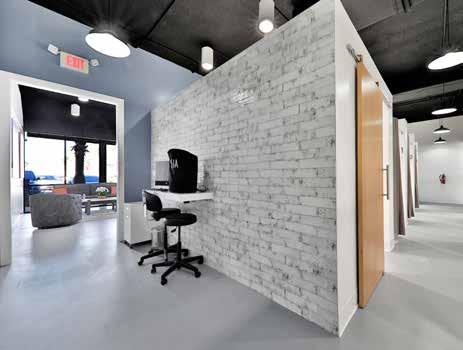
– Slade Sundar

to be owned and operated by physicians to uphold the safety of our clients and our physician-created skin health approach as we expand across the country.
Walk us through how and why your location is designed the way it is?
Slade: My sister and I spent a lot of time thinking about the way the space would be designed. The design of the spa is a mixture of form and function. We had to ensure we were making the space efficient, but it also needed to feel open and inviting. We hired the architects at Interplan LLC because executing the vision in our heads was going to be a huge challenge, and we needed architects that could really help us visualize the end result. We had to achieve our vision with a relatively small budget, and the design had to be repeatable and extensible enough that we could use it as a template to franchise in the future. Our concept for the space blended the idea of a modern art gallery with an aesthetic spa and a community space. We also were limited by minimal square footage and minimal ceiling heights—but we needed to fit eight treatment rooms, a large comfortable retail area, two bathrooms, an office, storage and the kicker: We wanted the space to have the flexibility to convert the retail space into an after-hours event space for seminars.
Dr. Kalpana: We also needed to make sure that clients could enter and exit without feeling like they were physically bumping into other people, which is especially important in a post-COVID world. We didn’t have a back door in the space we were building in, so we designed the space with a single-direction flow. Clients coming in throughout the day are able to continuously circulate through the treatment areas and retail area without any bottlenecks. The design principles come from art museums that generally provide a one-direction flow. Each client will enter and exit through the gift shop, aka, our retail/lobby area.
Slade: With any brick and mortar location, you have to provide phenomenal service to your customers: a premium “must-have” experience. But that alone isn’t enough to draw in and retain customers. Now more than ever, you have to create a “must-visit” destination. And that’s the vision we had in our heads. Interplan really came through, bringing the vision to life with an efficient, beautiful layout that is repeatable for franchisees.
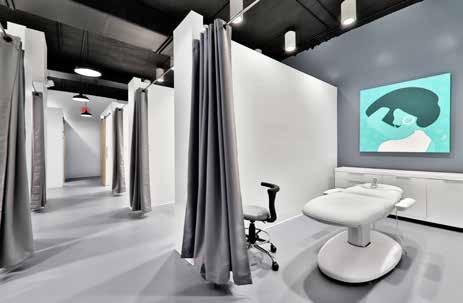

– Dr. Kalpana Sundar
Give us a rundown of your market’s layout.
Dr. Kalpana: Our market is complex, as there are traditional skin spas that offer
manual “fluff and buff” facials, as well as medical spas that offer a mixed-bag of medically effective treatments from skincare to body sculpting in a clinical setting. Both are confusing to the average person and miss the mark in a few ways when it comes to long-term skin health, so we wanted Kalvera to solve that. The big problem with medical spas is that they typically only cater to a much older audience and have a big focus on injectables. In the minds of anyone under 35, a medical spa is where “old” people go to get Botox. Most are run by male doctors who spend their marketing dollars on making women feel bad about themselves so they will spend more on Botox. They never really focus on prevention.
Slade: The other end of the skincare spectrum is skin spas or facial bars. These are where you go in for a “relaxing facial” and you have an esthetician rub products on your face manually. These are minimally effective, and most of what they rub on your skin, stays on top of your skin, and the nutrients aren’t absorbed. They are better than nothing, but if you’re serious about reversing something like consistent sun damage, they aren’t going to do much. That’s why our approach is to use treatments like our Dermafacial, which includes a med-tech device that exfoliates, extracts pores and infuses nutrients into the skin.
What’s the biggest issue today related to the construction side of the business?
Slade: The largest challenges that the construction industry faces right now, and what we faced when we started building in mid 2020, are definitely COVID-related. The worst effect is the long lead times on construction materials and components, and with city government staff not having a consistent way of dealing with inspections and approvals because everything was constantly changing during the time we were building. We were lucky to engage with a forward-thinking construction company, J. Lane Construction. How they worked around this issue was by leveraging relationships, planning ahead with project management software, posting daily reports showing project status/ delays/photos/etc., and even just regular old group calls hosted weekly that ensured we were ahead of the issues as much as possible. They were our eyes and hands, and were able to leverage relationships to minimize our construction delays. We were delayed by three months due to COVID, but it could have been much worse without the quick actions of the J. Lane team. CCR
What’s the most rewarding part of your job?
When clients walk out with a big smile on their faces and they feel good about themselves, their energy has shifted and their outlook for the day has improved. Once people feel better about themselves, everything is possible. When people look in the mirror and like what they see, it makes dealing with everything the world throws at you a little easier.
Describe a typical day at Kalvera.
My day is split between seeing clients at the location and being involved in the Jacksonville and Jax Beach community. I make it a point to meet small businesses in the community and see how we can support each other by forming partnerships with other women-owned or BIPOC-owned businesses.
Best advice you ever received?
You’ll never work a day in your life if you do what you love and if you enjoy the people you work with. That’s something I take to heart and can definitely say is true with Kalvera.
Best thing a client ever said to you?
When people look in the mirror and say, “Wow, I didn’t think it was possible for me to look this great without surgery.” I feel rewarded by having the opportunity to educate people about skin health, restoring the skin’s natural defenses, and helping people see the results they can experience without pursuing invasive, aggressive measures like surgery.
How do you like to spend your downtime?
There’s not a lot of downtime when starting a new business, but I’m someone who always likes to stay busy regardless. When I do have downtime from Kalvera, I’m writing music, at the race track, playing with my dog, or kickboxing and traveling.


